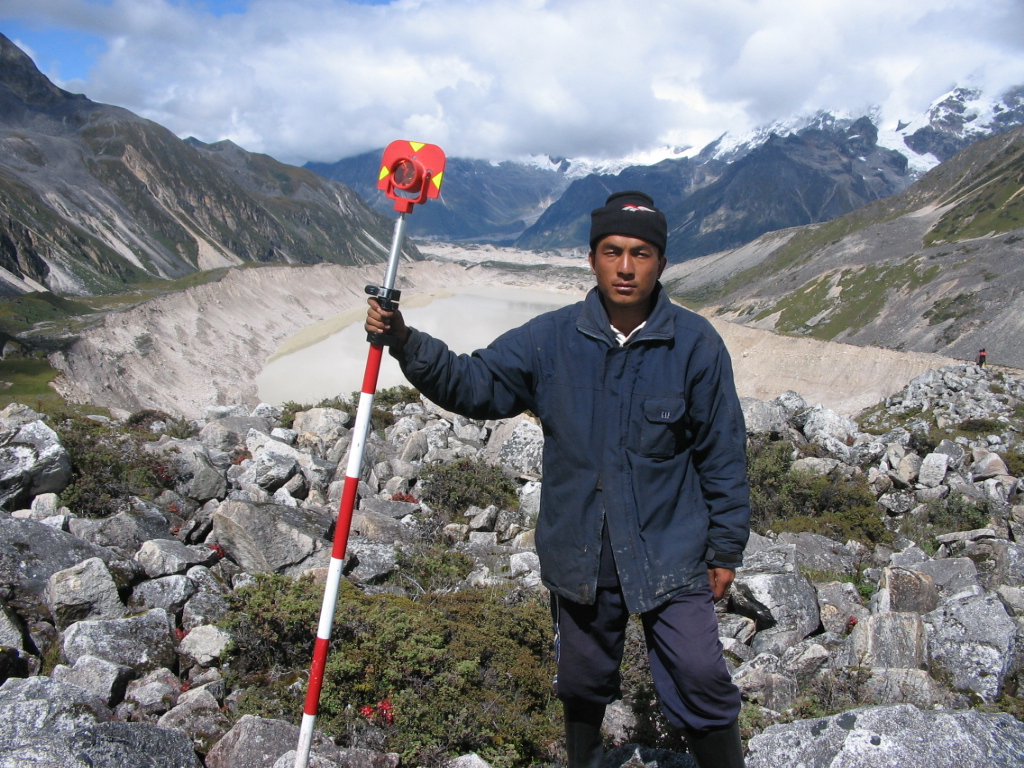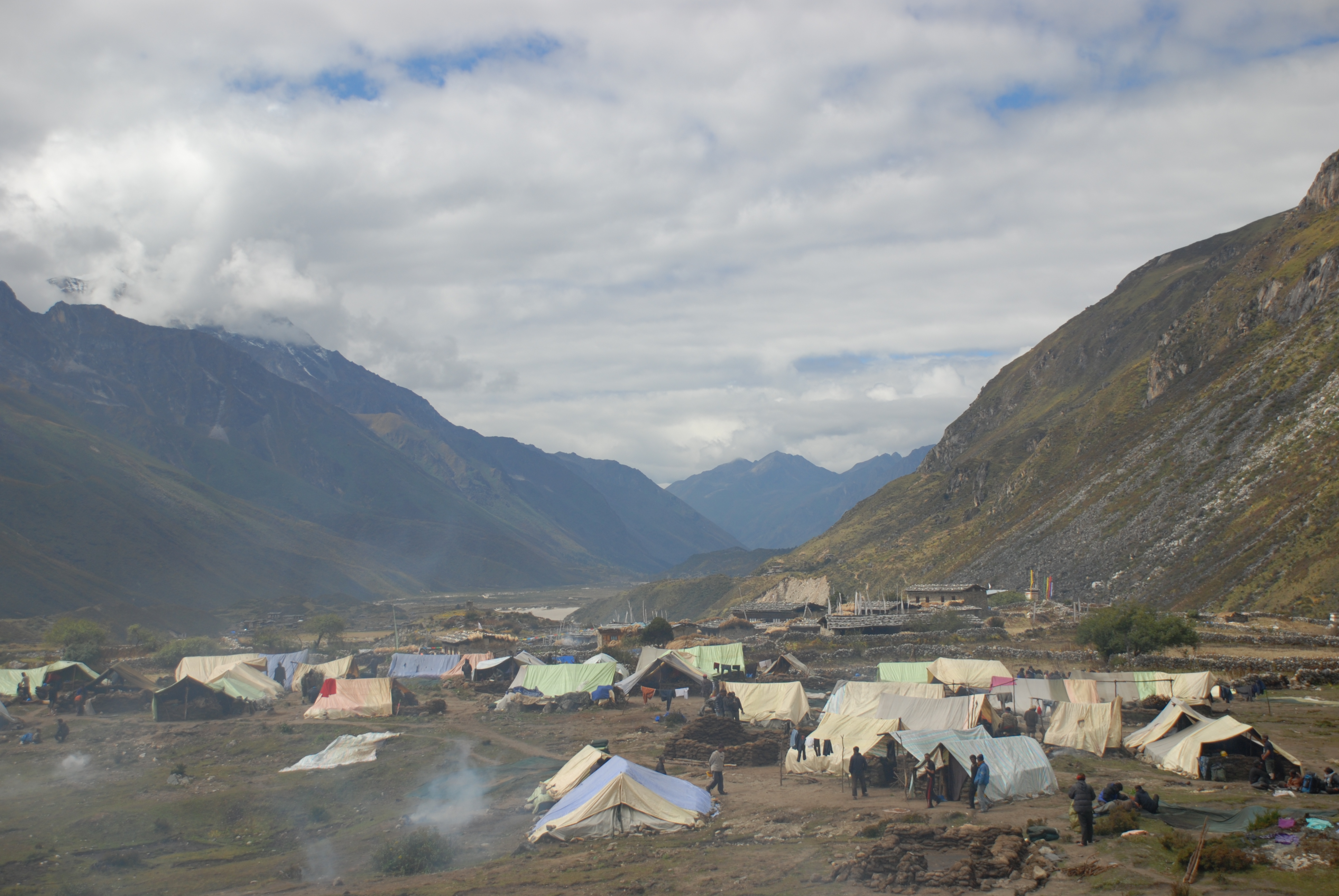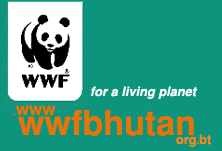Reducing Climate Change-induced Risks from Glacial Lake Outburst Floods in Bhutan
Project Overview
This project, Reducing Climate Change-induced Risks and Vulnerabilities from Glacial Lake Outburst Floods in the Punakha-Wangdi and Chamkhar Valleys, was identified by the National Adaptation Programme of Action of Bhutan as a national priority to address the adverse impacts of climate change. Its goal is to enhance adaptive capacity to climate change-induced disaster impacts in Bhutan. As a contribution to the achievement of this goal, the project objective is to 'reduce climate change-induced risks and vulnerabilities from glacial lake outbursts in the Punakha-Wangdi and Chamkhar Valleys.' The project is anticipated to contribute to risk reduction, improved safety and increased awareness in the involved districts through:
- Systematization and long-term planning of Bhutan’s legal framework and awareness on disaster risk management
- Artificial lowering of the potentially dangerous Thorthormi glacier lake
- Automation and expansion of early warning mechanisms in the Punakha-Wangdue valley
For updates on UNDP Early Warning Systems and Climate Resilient Development projects, click here.
Project Details
The most significant impact of climate change in Bhutan is the formation of supra-glacial lakes due to the accelerated retreat of glaciers with increasing temperatures. Glaciers in Bhutan are receding at a rate of 30-60 meters per decade. The melting ice from these receding glaciers is increasing the volume of water in glacial lakes, and the melting of ice-core dams is destabilizing them, pushing the hazard risk for Glacial Lake Outburst Floods (GLOFs) to critical levels. The risk of potential disasters inflicted by GLOFs, pose new threats to lives, livelihoods and development. The risks are mounting as water levels in several glacier lakes approach critical geostatic thresholds.
A significant portion of the country’s revenue projected to 60% is derived from hydropower, which has involved huge investments in infrastructure and requires sustainable water resources. Other sectors are also highly vulnerable to the adverse effects of climate change. Agriculture in Bhutan provides livelihoods and employment to 79% of the population. The majority of the people practice subsistence farming on small marginal land holdings which are extremely vulnerable to flood impacts.
As a follow up to the UNDP-supported National Adaptation Programme of Action (NAPA, 2006), Bhutan is currently implementing the first project funded by the Least Developed Countries Fund on Climate Change Adaptation titled “Reducing climate change induced risks and vulnerabilities from glacial lake outburst floods in the Punakha, Wangdue and Chamkhar Valleys”. The project is addressing climate risks in two Sub Basins - Pho Chhu and Chamkhar Chhu - which represent the two most GLOF-vulnerable areas in the country and pose a major threat to life and infrastructure in downstream communities. Approximately 10% of the Bhutanese population lives in these two areas. The Pho Chhu flows into Puna Tshang Chhu, the country's longest river, along which there are emerging townships, important historical structures, major hydropower projects, farmland, and public infrastructure projects. The Chamkhar valley is an important emerging urban, tourist, and economic hub.
The goal of the project is to enhance adaptive capacity to prevent climate change-induced GLOF disasters in Bhutan. The development objective of the project is to reduce climate change-induced risks of Glacial Lake Outburst Floods (GLOFs) in the Punakha-Wangdue and Chamkhar Valleys.
Project implementation started in 2008 and will continue until mid-2013. The project is implemented by the Royal Government of Bhutan: the Department of Disaster Management (DDM) implementing outcomes 1 and 3, the Department of Geology and Mines (DGM) implementing outcome 2, and Department of Energy (DOE) implementing outcome 3. The UNDP Country Office in Bhutan, with assistance from UNDP Asia-Pacific Regional Center, is ensuring oversight, monitoring, evaluation and technical guidance of all outcomes and is responsible for outcome 4 related to Knowledge Management, along with the Project Board (PB) and the Technical Support Advisory Team (TSAT), comprised of key stakeholders from the Royal Government of Bhutan and funding agencies.
Project implementing partners and stakeholders:
Key Results and Outputs
The project’s goal is to enhance adaptive capacity to prevent climate change-induced GLOF disasters in Bhutan and its objective is to reduce GLOF risks in the Punakha-Wangdi (PW) and Chamkhar Valleys.
The project is organized according to the following four outcomes and subsidiary outputs:
- Improved national, regional, and local capacities to prevent climate change-induced GLOF disasters in the PW and Chamkhar Valleys Institutionalized climate-resilient DRM legislation, policy frameworks, and guidelines. Strengthened capacities for climate risk planning at the district (dzongkhag) administrative levels. Information on climate hazards and GLOF vulnerabilities in Bhutan systematically captured, updated,and synthesized. Awareness raised in communities vulnerable to climate-related GLOF risks.
- Reduced risks of a GLOF from Thorthormi Lake through an artificial lake level management system Engineering and safety plans for risk reduction measures on Thorthormi Lake developed. Lowered Thorthormi Lake water levels. Water levels of Thorthormi Lake and status of artificial lowering system regularly monitored and maintained. Technical knowledge and lessons from the process of artificially lowering lake levels captured and documented for use in future projects.
- Reduced human and material losses in vulnerable communities in the PW Valley through GLOF early warnings Technical components for a GLOF EWS in PW Valley installed and operational. Established institutional arrangements to operate, test, and maintain the GLOF EWS. Raised awareness of communities in the PW Valley on operation of EWS. Raised awareness of safe GLOF evacuation areas in each vulnerable community in the PW Valley. Technical knowledge and lessons learned in the installation and operation of GLOF EWS captured and documented for use in future projects.
- Enhanced learning, evaluation, and adaptive management Project lessons captured and disseminated through the Adaptation Learning Mechanism. Project knowledge shared with other GLOF-prone countries.
Outcome 1: Policy, capacity development and CBDRM
The development objective of the project outcome 1 is to improve national, regional and local capacities to prevent climate change-induced GLOF disasters. Therefore, under outcome 1: “Improved national, regional and local capacities to prevent climate change-induced GLOF disasters in the Punakha-Wangdue and Chamkhar Valleys’, the project works with all levels of society to inform, prepare and strengthen their ability to respond to GLOF risks from Thorthormi Glacier Lake, one of Bhutan’s most dangerous glacier lakes with an earlier worst-case-scenario outburst projection as early as 2010.
Extensive awareness and advocacy activities are being undertaken at the national, district, sub-district and community levels. A bottom-up approach for Community-Based Disaster Risk Management (CBDRM) includes the formation of district and sub-district Disaster Management (DM) committees and planning teams. These groups have participated in orientations and “training of trainers” workshops and have, therefore, been able to train and sensitize local community/village leaders and communities. Based on the trainings, DM plans are being developed at 'chiwog' (group of villages), ‘gewog’ (sub-district), and dzongkhag (district) levels in all three pilot districts of Punakha, Wangdue and Bumthang.
At the policy-level, a draft DM Bill has been formulated with support from the project and reviewed several times by national stakeholders as well as by independent international experts and UNDP in consultation with international stakeholders. Once enacted, the DM Act is expected to strengthen the institutionalization of DM piloted by the project at national and local levels.
For more information and achievements to date, please refer to the project factsheets available for download under project documents.
Outcome 2:
The development objective of the project outcome 2 “Reduced risks of GLOF from Thorthormi Lake through an artificial lake level management system” is increasing safety for downstream communities and infrastructure. With a majority of Bhutan’s population, economic activities and infrastructure development concentrated in large river valleys, climate-induced GLOFs could cause colossal human and economic devastations. The reduced risks of GLOFs will not only benefit vulnerable communities in the Punakha-Wangdue valley in Bhutan, but also communities that are located further down the river, such as the northern states of India.
Preparatory studies, such as Engineering and Safety Plans and Environmental Impact Assessment, for the artificial lowering of Thorthormi glacial lake, one of Bhutan’s most dangerous glacier lakes, were carried out in 2008. Since 2009, a multidisciplinary team and approximately 350 workers have been working from July to October every year to drain water out of the lake to release the pressure on the thinning moraine dam and avoiding the earlier worst-case-scenario outburst projection as early as 2010. Since use of heavy machinery at the site would further destabilize the moraine dam of the glacial lake, the excavation work at Thorthormi Lake is done manually with simple tools and instruments to dig ice and remove boulders, thereby, creating a channel to drain out water. This approach has provided income to more than 350 local workers and contributes to local enterprise development through their savings.
Thorthormi Lake is located 9 days trek from the road in a harsh, high-altitude environment above 4,300 m, and therefore poses challenges related to transportation, equipment, and limited accessibility to the project as well as the health and safety of project staff and workers. As a result of the limited accessibility to the work site - only 3-4 months a year because of extreme weather conditions - the project has gained experience in planning field work well in advance to optimize the working period and to maintain the interest and motivation of workers as well as for transportation, health and safety procedures, minimizing environmental impacts and multi-disciplinary workforce management.
For more information and achievements to date, please refer to the project factsheets available for download under project documents.
Outcome 3: Early Warning System and awareness
Under Outcome 3: “Reduced human and material losses in vulnerable communities through GLOF early warnings”, the project is addressing the vulnerabilities of communities lying along the Punakha-Wangdue valley. Villages located in high risk zones along the Punatshangchhu River, the country’s longest river, include emerging townships, important historical structures, major hydropower projects, farmland, and public infrastructural projects. All of these face human and material losses if the river floods due to GLOFs.
The installation of the automatic GLOF Early Warning Sytem (EWS) started in 2010 and was completed in 2011. The automatic EWS is comprised of 17 sirens, 4 automatic water level stations and 3 automatic weather stations that have been successfully installed and are fully functional. A Flood Warning Control Station is manned by 2 technicians 24 hours a day, and linked with the Flood Warning system of Bhutan that shares water level data with the Indian states of Assam and West Bengal.
The EWS installation is supported by community awareness activities, and demarcation of GLOF red zone areas and safe evacuation sites in all vulnerable communities based on GLOF hazard zonation mapping. The automatic EWS is also supported by an interim manual EWS based on appointed community focal points in the 21 most vulnerable communities in the Punakha-Wangdue valley. The combination of the automatic EWS and awareness activities is expected to provide long-term impact on the lives of all vulnerable communities lying along the Punakha-Wangdue valley. Community members will be able to identify high risk areas and move to safer sites if the sirens are activated. In addition to communities in Punakha-Wangdue valley, the EWS will benefit communities that are located further down the river, such as the northern states of India.
Samdingkha Siren, Bhutan.
For more information and achievements to date, please refer to the project factsheets available for download under project documents.
Outcome 4: Knowledge management
Outcome 4: Enhanced learning, evaluation and adaptive management: Lessons learned from the project have been disseminated through the Adaptation Learning Mechanism, various media and advocacy materials (including TV documentaries and articles), and have also resulted in replica projects in Pakistan and Nepal through information sharing. The project is also proposed to be replicated in other valleys in Bhutan, increasing its potential impact nation-wide.
An International GLOF risk reduction conference is planned to take place towards the end of the project.
For more information, please refer articles, publications, ALM case study, and project factsheets available for download under project documents and publications as well as links to project documentaries/films.
Reports and Publications
Highlights
Assessments and Background Documents
Board Meeting Reports
Remarks by UN Resident Coordinator - Inception workshop 2008
ProDocs
Relevant Peer-Reviewed Articles
Brochures, Posters, Communications Products
Solutions Exchange - Community Involvement and Early Warning System - Bhutan
News article
New York Times - Working in the Himalayas to Prevent Dissastrous Flooding
Project Brief / Fact Sheet
Inception Report fot Installation of Glacial Lake Outburst Flood Early Warning System in the Punakha-Wangdi Valley
Document
Knowledge Products
Disaster Management Committee of Bumthan Dzongkhag - 2010 - Bhutan
Multimedia
A Deluge of Consequences
A Deluge of Consequences by Jacques Leslie
Faced with the imminent threat of a devastating flood caused by climate change, each summer the Bhutanese government sent 300 workers up an arduous Himalayan trail to a glacial lake in danger of bursting. Author Jacques Leslie draws upon participants' photographs to depict the workers' heroic, high-altitude mission.
Silent Tsunami
This project was identified by the National Adaptation Programme of Action of Bhutan as a national priority to address the adverse impacts of climate change. Its goal is to enhance adaptive capacity to climate change-induced disaster impacts in Bhutan. As a contribution to the achievement of this goal, the project objective is to 'reduce climate change-induced risks and vulnerabilities from glacial lake outbursts in the Punakha-Wangdi and Chamkhar Valleys.'
Bhutan Video: Himalayan Meltdown Trailer
Revealed: The Himalayan Meltdown is a 45-minute documentary film co-produced by the UN Development Programme, Discovery Asia, and Arrowhead Films. The movie examines the human development impact of the glacial ice melt on communities in Bangladesh, Bhutan, China, India and Nepal. It shows the plight of the affected countries and the ways they are adapting, adjusting and preparing for tomorrow’s inevitable changes in the Himalayan glaciers.
Monitoring and Evaluation
Project monitoring and evaluation is being conducted in accordance with established UNDP and GEF procedures and is provided by the project team and the UNDP Country Office (UNDP-CO) with support from UNDP-GEF.
Links
Contacts
Worked with vulnerable communities to build community-based disaster risk management plans.









